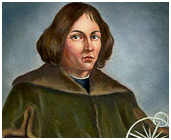Nicolaus Copernicus was the first astronomer who formulated that sun is at the center of the solar system. Find more information on Copernicus in this brief biography & profile.
Nicolaus Copernicus
Born on: 19 February, 1473

Born in: St. Anne's Street in Torun, Poland
Nationality: Polish
Career: Astronomer
Died on: 24 May, 1543
Nicolaus Copernicus was the first astronomer who formulated a scientific heliocentric cosmology that displaced the Earth from the center of the Universe. He was also the author of the book, titled, 'De revolutionibus orbium coelestium' (On the Revolutions of the Celestial Spheres). It is often regarded as the starting point of the modern astronomy.
He was also a mathematician, physician, classical scholar, translator, Catholic cleric, jurist, governor, military leader, diplomat and economist.
Childhood
Nicolaus Copernicus was born on February 19, 1473 on St. Anne's Street in the city of Torun, in the Kingdom of Poland. Nicolaus was named after his father who was a very rich copper trader and was also a much respected citizen of the city. Nicolaus' mother, Barbara Watzen was also very rich and was born into a wealthy merchant family that was part of the patrician class in Torun. Nicolaus's father died sometime between 1483 and 1485. Subsequently, his maternal uncle Lucas Watzenrode the Younger took care of him and also took care of his education and future career.
Nicolaus Copernicus was the youngest of the four children. His brother Andreas became an Augustinian canon at Frombork while his sister Barbara became a Benedictine nun. His other sister Katharina married Barthel Gartner who was a businessman and a city councilor.
It was in the year 1491, when Copernicus enrolled himself at the Krakow Academy. Here, he was introduced to astronomy by Professor Albert Brudzewski. Astronomy started to fascinate him and he began to collect large books on this subject.
Nicolaus stayed in Krakow for four years and then he went back home in Torun to study law and medicine at the Universities of Bologna and Padua. His uncle financed all his education and wanted him to become a bishop. But Copernicus, however, met the famous astronomer, Domenico Maria Novara da Ferrara while he was studying law. He also attended Domenico's classes and lectures and even became his assistant. Copernicus made his first observations in the year 1497, together with Novara and this is documented in the book De revolutionibus orbium coelestium.
Early Career
In the year 1501, Copernicus returned to Frombork and he obtained permission from his uncle to complete his studies in Padua where he studied medicine. Later, in the year 1503, he also went on to receive his Doctorate Degree in Canon Law. One of the topics he studied at that time was astronomy since it was considered very important part of medical education.
It seems that although Copernicus studied astronomy, he never quite practiced it, or expressed any kind of further interest in the subject. It is also believed that it was in Padua that he encountered some passages from Cicero and Plato regarding the movement of Earth and he formed his first theory in this way. Later, in the year 1504, Copernicus began to collect observations and ideas that were very important to his theory in the field of astronomy.
Work
In the year 1503, Copernicus returned to Poland, where he resided for the rest of his life. From 1503 to 1510, he held the position of Secretary to his uncle Lucas and also resided in the Bishop's castle till 1510. It was here that he started to work on the heliocentric cosmology.
Copernicus also oversaw the defense of the castle of Olsztyn at the Royal Polish Forces during the Polish-Teutonic War (1519-1521). Later on, he also participated in the various peace negotiations. Copernicus also worked as an advisor to Poland's King Sigismund I the Old and helped him on the monetary reform system. He traveled extensively on Government work as a diplomat on behalf of the Prince-Bishop of Warmia as well.
In 1526, Copernicus completed a research work on the value of money and even formulated his theory, which is popularly known as the 'Gresham's Law'. Not only this, he also formed another theory on the ‘Quantity of Money’. By the year 1533, Copernicus’ work began to be known to the general public and had also taken a definitive form. The various rumors about his theory also had reached the people of Europe.
Personal Life
It is widely believed that Nicolaus Copernicus never married because he was too dedicated to his work. He died on May 24, 1543 in Frombork. According to records, the first copy of his book was placed in his hands on the day he died. He was buried in the Cathedral of Frauenburg where archaeologists had searched in vain for the remains, ever since.
However, in the year 2005, some archaeologists did find some remains which are believed to be that of Copernicus. The experts also determined that the skull which was found belonged to a man who was about 70 years of age when he died, which was Copernicus's age at the time of his death. However as the grave was in poor condition, not all the remains were found.
See also
More from iloveindia.com
- Home Remedies | Ayurveda | Vastu | Yoga | Feng Shui | Tattoos | Fitness | Garden | Nutrition | Parenting | Bikes | Cars | Baby Care | Indian Weddings | Festivals | Party ideas | Horoscope 2015 | Pets | Finance | Figures of Speech | Hotels in India : Delhi | Hyderabad | Chennai | Mumbai | Kolkata | Bangalore | Ahmedabad | Jaipur
- Contact Us Careers Disclaimer Privacy Policy Advertise With Us Lifestyle Sitemap Copyright iloveindia.com. All Rights Reserved.






